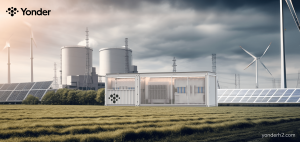Introduction
In the ever-evolving landscape of sustainable energy solutions, microgrids are emerging as a powerful tool for decentralizing energy generation and enhancing resilience. Among the various technologies contributing to the success of microgrids, hydrogen stands out as a versatile and clean energy carrier. This blog will explore the applications of hydrogen in microgrids, shedding light on how it can revolutionize decentralized energy systems.
Energy Storage and Balancing
One of the primary challenges in microgrid management is the intermittent nature of renewable energy sources. Hydrogen can serve as an efficient means of energy storage. During periods of excess energy production, especially from solar or wind sources, surplus electricity can be used for electrolysis to produce hydrogen. This hydrogen can then be stored and later converted back to electricity through fuel cells when energy demand exceeds generation, ensuring a continuous and stable power supply within the microgrid.
Renewable Integration
Hydrogen facilitates the seamless integration of renewable energy sources into microgrids. As the demand for clean energy grows, microgrids can leverage hydrogen as an energy carrier to store and distribute power generated from wind, solar, and other renewable sources. This not only enhances the reliability of microgrids but also reduces dependency on traditional grid infrastructure.
Backup Power and Resilience
Hydrogen fuel cells can act as a reliable backup power source in microgrids, ensuring uninterrupted electricity supply during grid outages. This is particularly beneficial for critical infrastructure such as hospitals, data centers, and emergency services. The ability of hydrogen-based systems to operate independently enhances the resilience of microgrids in the face of natural disasters or other disruptions.
Remote and Off-Grid Applications
Microgrids are crucial in providing power to remote or off-grid locations. Hydrogen’s portability and energy density make it an excellent solution for powering off-grid microgrids. By generating hydrogen locally through renewable energy sources, these microgrids can operate independently, bringing electricity to areas where traditional grid extension is economically or logistically challenging.
Hydrogen-Powered Vehicles in Microgrid Fleets
Integrating hydrogen-powered vehicles within microgrid fleets enhances the overall sustainability of transportation and energy systems. These vehicles can serve as mobile energy storage units, capable of supplying power back to the microgrid when needed. This two-way interaction between transportation and energy sectors fosters a more integrated and efficient energy ecosystem.
Community Empowerment
Hydrogen-powered microgrids empower communities by offering local control over energy production and consumption. This not only fosters energy independence but also enables communities to make environmentally conscious choices. Residents can actively participate in energy production through distributed hydrogen generation, fostering a sense of ownership and responsibility for sustainable practices.
Conclusion
Hydrogen’s applications in microgrids mark a significant leap towards decentralized, resilient, and sustainable energy systems. As the world seeks alternatives to centralized power distribution, microgrids powered by hydrogen emerge as a beacon of innovation. The synergy between hydrogen technology and microgrid infrastructure not only addresses current energy challenges but paves the way for a more resilient, efficient, and sustainable energy future.





